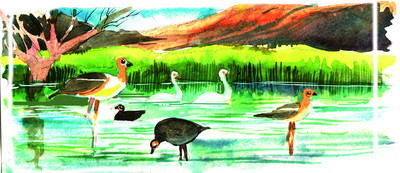Nature abounds inside valley at Floyd Lamb, Gilcrease
Despite encroachment by urban housing tracts, portions of the northwestern Las Vegas Valley retain their rural feel, especially at Floyd Lamb State Park at Tule Springs, a former "divorce ranch" as well as working livestock spread.
Nearby, fragmented remnants of other old ranches and an agricultural past persist. Look for them in little-known places such as the Gilcrease Nature Sanctuary and the Gilcrease Orchard, a seasonal resource for fresh fruit you pick yourself.
Readily accessible, the region lies within sight of U.S. 95, about 10 miles north of downtown Las Vegas. Exit U.S. 95 at Durango Drive, following it east, then north. Drive through an area crowded with housing and businesses past the major stop at Elkhorn. Signs indicate the approach to the city park at Tule Springs. The park boasts intact historical buildings, picnic areas, strands of shade trees, walking trails near large ponds stocked with fish, and horse-drawn carriage rides. Entrance costs $6 per vehicle.
Not as well marked, the Gilcrease Nature Sanctuary lies south of the park. Watch for a street called Racel on the right a couple of blocks beyond Elkhorn. Turn east on Racel and drive a few blocks, watching for a small sign on a little side street. The preserve occupies several acres adjacent to Racel, housing some 2,000 birds and animals.
Open all year from 10 a.m. to 3 p.m. Wednesdays through Sundays, the preserve invites guests to stroll the grounds and meet the creatures living there. Entrance costs $4 for adults, $3 for seniors and military personnel, and $1 for children age 12 or younger. Children must be accompanied by an adult. Please leave pets at home.
Inside the entry gate opposite the office, a newly enlarged fish pond occupies a place of pride. A network of paths fans out from there, inviting exploration of buildings housing exotic birds, pond areas for water birds, fenced enclosures for poultry, peacocks, pot-bellied pigs, ostriches, emus and rheas, and sheltered corrals for goats, donkeys, ponies, llamas and cattle.
Although shelters and enclosures range over the acreage haphazardly, they seem sturdy and clean. The animals appear healthy, well-fed and well-maintained. They have plenty of shade, ample water and a wide variety of fruits and vegetables in addition to formulated feed and hay. It appears they benefit from produce culled from area supermarkets. At the entrance, visitors may purchase raw, unsalted peanuts in the shell to feed the birds and animals.
The critters also appear to enjoy the attention they get from visitors, especially groups of schoolchildren. Although warned to keep fingers away from the many kinds of colorful parrots and the huge ostriches, youngsters delight in being able to get close enough to pet new baby goats, small horses and burros, and a couple of gentle cows. They gaze in wonder at the enormous flightless birds, amazed at the size of the eggs gathered in shallow nests in the dirt.
Now in his 90s, William Gilcrease still works with staff and volunteers to care for the creatures at the nonprofit sanctuary he created on the site of an ancient spring, where scientists still unearth fossil remains of mammoths, camels and prehistoric horses. His lifelong interest and skill in handling animals led to development of the facility not far from the original Gilcrease Ranch. At first intended to house native domestic and exotic birds, the preserve expanded to include many other creatures in need of a safe haven.
On another agricultural remnant not far distant, the Gilcrease Orchard provides fresh fruit from summer through fall. The pet project of another Gilcrease son, now deceased, the orchard occupies acreage at Tenaya and Whispering Sands. Despite its intended protection under a nonprofit foundation, the orchard seems to be about half the size it was just a couple of seasons ago. Plan a trip to the orchard to pick fruit far more delicious than any you find in stores. Bring bags, boxes, water and wet wipes. You weigh the fruit and pay nominal fees on the way out. Check out www. gilcreasenaturesanctuary.org and its link to the orchard for details.
Margo Bartlett Pesek's column appears on Sundays.






















